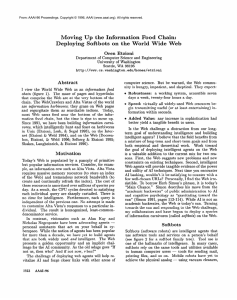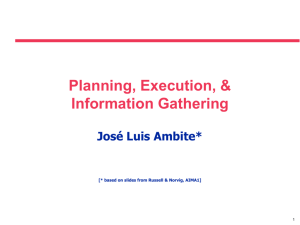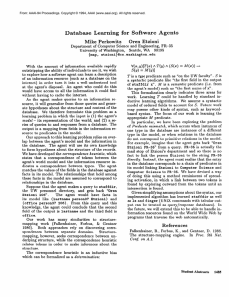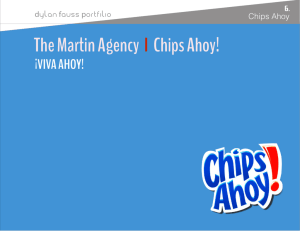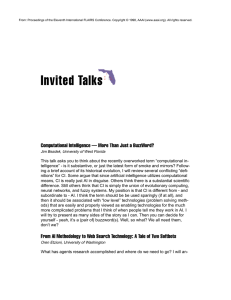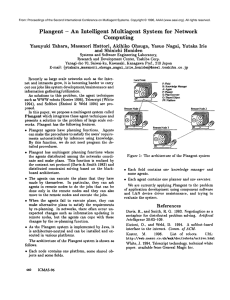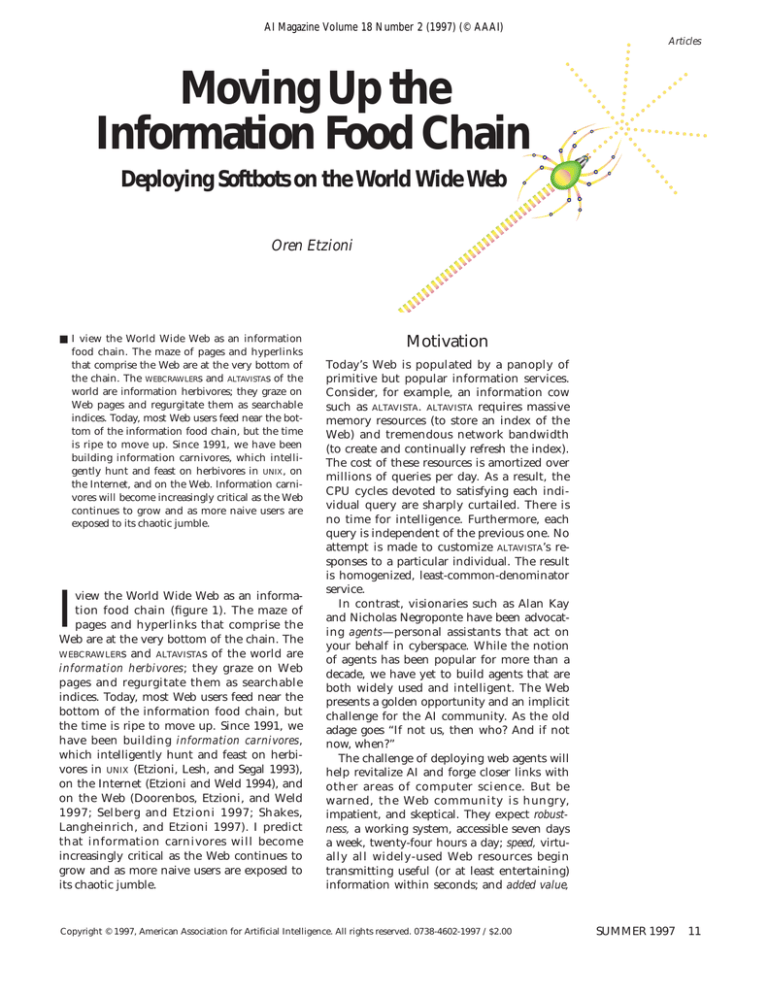
AI Magazine Volume 18 Number 2 (1997) (© AAAI)
Articles
Moving Up the
Information Food Chain
Deploying Softbots on the World Wide Web
Oren Etzioni
■ I view the World Wide Web as an information
food chain. The maze of pages and hyperlinks
that comprise the Web are at the very bottom of
the chain. The WEBCRAWLERs and ALTAVISTAs of the
world are information herbivores; they graze on
Web pages and regurgitate them as searchable
indices. Today, most Web users feed near the bottom of the information food chain, but the time
is ripe to move up. Since 1991, we have been
building information carnivores, which intelligently hunt and feast on herbivores in UNIX, on
the Internet, and on the Web. Information carnivores will become increasingly critical as the Web
continues to grow and as more naive users are
exposed to its chaotic jumble.
I
view the World Wide Web as an information food chain (figure 1). The maze of
pages and hyperlinks that comprise the
Web are at the very bottom of the chain. The
WEBCRAWLERs and ALTAVISTAs of the world are
information herbivores; they graze on Web
pages and regurgitate them as searchable
indices. Today, most Web users feed near the
bottom of the information food chain, but
the time is ripe to move up. Since 1991, we
have been building information carnivores,
which intelligently hunt and feast on herbivores in UNIX (Etzioni, Lesh, and Segal 1993),
on the Internet (Etzioni and Weld 1994), and
on the Web (Doorenbos, Etzioni, and Weld
1997; Selberg and Etzioni 1997; Shakes,
Langheinrich, and Etzioni 1997). I predict
that information carnivores will become
increasingly critical as the Web continues to
grow and as more naive users are exposed to
its chaotic jumble.
Motivation
Today’s Web is populated by a panoply of
primitive but popular information services.
Consider, for example, an information cow
such as ALTAVISTA. ALTAVISTA requires massive
memory resources (to store an index of the
Web) and tremendous network bandwidth
(to create and continually refresh the index).
The cost of these resources is amortized over
millions of queries per day. As a result, the
CPU cycles devoted to satisfying each individual query are sharply curtailed. There is
no time for intelligence. Furthermore, each
query is independent of the previous one. No
attempt is made to customize ALTAVISTA’s responses to a particular individual. The result
is homogenized, least-common-denominator
service.
In contrast, visionaries such as Alan Kay
and Nicholas Negroponte have been advocating agents—personal assistants that act on
your behalf in cyberspace. While the notion
of agents has been popular for more than a
decade, we have yet to build agents that are
both widely used and intelligent. The Web
presents a golden opportunity and an implicit
challenge for the AI community. As the old
adage goes “If not us, then who? And if not
now, when?”
The challenge of deploying web agents will
help revitalize AI and forge closer links with
other areas of computer science. But be
warned, the Web community is hungry,
impatient, and skeptical. They expect robustness, a working system, accessible seven days
a week, twenty-four hours a day; speed, virtually all widely-used Web resources begin
transmitting useful (or at least entertaining)
information within seconds; and added value,
Copyright © 1997, American Association for Artificial Intelligence. All rights reserved. 0738-4602-1997 / $2.00
SUMMER 1997
11
Articles
Ahoy!
MetaCrawler
Personal
Assistants
Softbots
Alta Vista
Yahoo
Indices,
Directories
Mass
Services
World Wide Web
Figure 1. The Information Food Chain.
any increase in sophistication had better
yield a tangible benefit to users.
Is the Web challenge a distraction from our
long-term goal of understanding intelligence
and building intelligent agents? I believe that
the field benefits from a mixture of long-term
and short-term goals and from both empirical
and theoretical work. Work toward the goal
of deploying intelligent agents on the Web is
a valuable addition to the current mix for two
reasons. First, the Web suggests new problems
and new constraints on existing techniques.
Second, intelligent Web agents will provide
tangible evidence of the power and utility of
AI techniques. Next time you encounter AI
bashing, wouldn’t it be satisfying to counter
with a few well-chosen URLs?
Personally, I find the Web irresistible. To
borrow Herb Simon’s phrase, it is today’s
“Main Chance.” Simon describes his move
from the “academic backwater” of public
administration to AI and cognitive psychology as “gravitating toward the sun” (Simon
1991, pp. 113–114). Although AI is not an
academic backwater, the Web is today’s sun.
Turning towards the sun and responding to
the Web challenge, my collaborators and I
have begun to deploy a species of information carnivores (called softbots) on the Web.
Softbots
Softbots (software robots) are intelligent agents
that use software tools and services on a person’s behalf (figure 2). Tool use is one of the
12
AI MAGAZINE
hallmarks of intelligence. In many cases, softbots rely on the same tools and utilities available to human computer users—tools for
sending mail, printing files, and so on. Mobile
robots have yet to achieve the physical analog—using vacuum cleaners, lawn mowers,
etc. Softbots are an attractive substrate for
intelligent-agent research for the following
reasons (Etzioni 1994, 1993). First, the cost,
effort, and expertise necessary to develop and
systematically experiment with software artifacts are relatively low. Second, software environments circumvent many of the thorny but
peripheral problems that are inescapable in
physical environments. Finally, in contrast to
simulated physical worlds, software environments are readily available (sophisticated simulations can take years to perfect), intrinsically interesting, and real. However, Softbots are
not intended to replace robots; Robots and
softbots are complimentary.
Much of our work has focused on the Internet softbot (also known as RODNEY) (Etzioni
and Weld 1994). RODNEY enables a person to
state what he or she wants accomplished. RODNEY disambiguates the request and dynamically determines how and where to satisfy it, utilizing a wide range of Internet services and
UNIX commands. RODNEY relies on a declarative
representation of the different software tools
at its disposal, enabling it to chain together
multiple tools in response to a user’s request.
RODNEY uses automatic planning technology
to dynamically generate the appropriate
action sequence. The Internet softbots project
has led to a steady stream of technical results
(Etzioni, Golden, and Weld 1997, 1994; Kwok
and Weld 1996; Perkowitz and Etzioni 1995;
Golden, Etzioni, and Weld 1994; Etzioni et al.
1992). Closely related projects include Kirk et
al. (1995) and Arens et al. (1993).
Unfortunately, we have yet to produce a
planner-based softbot that meets the stringent demands of the Web community. While
continuing our ambitious long-term project
to develop planner-based softbots, we have
embraced a new strategy for the creation of
intelligent agents which I call “useful first.”
Instead of starting with grand ideas about
intelligence and issuing a promissory note
that they will eventually yield useful intelligent agents, we take the opposite tack; we
begin with useful softbots deployed on the
Web, and issue a promissory note that they
will evolve into more intelligent agents. We
are still committed to the goal of producing
agents that are both intelligent and useful.
However, I submit that we are more likely to
achieve this conjunctive goal if we reverse the
Articles
Rodney
Sims
BargainFinder
MetaCrawler
Simon
ILA
InfoManifold
Occam
Ahoy!
ShopBot
Figure 2. The Softbot Family Tree.
The black boxes represent work at the University of Washington; the white boxes represent softbots currently deployed on the Web.
traditional sub-goal ordering and focus on
building useful systems first.
The argument for “useful first” is analogous
to the argument made by Rod Brooks (1991)
and others (Etzioni 1993; Mitchell et al. 1990)
for building complete agents and testing
them in a real world. As Brooks put it, “with a
simplified world…it is very easy to accidentally build a submodule of the systems which
happens to rely on some of those simplified
properties…the disease spreads and the complete system depends in a subtle way on the
simplified world” (p. 150). This argument
applies equally well to user demands and realtime constraints on Web agents.
There is a huge gulf between an AI prototype and an agent ready for deployment on
the Web. One might argue that this gulf is of
no interest to AI researchers. However, the
demands of the Web community constrain
the AI techniques we use, and lead us to new
AI problems. We need to recognize that intelligent agents are ninety-nine percent comput-
er science and one percent AI. The AI is critical but we cannot ignore the context into
which it is embedded. Patrick Winston has
called this the “raisin bread” model of AI. If
we want to bake raisin bread, we cannot
focus exclusively on the raisins.1
Operating on a shoestring budget, we have
been able to deploy several softbots on the
Web. I review our fielded softbots and then
consider both the benefits and pitfalls of the
“useful first” approach.
The METACRAWLER softbot (see www.cs.washington.edu/research/metacrawler) provides a
single, unified interface for Web document
searching (Selberg and Etzioni 1997, 1995).
METACRAWLER supports an expressive query language that allows searching for documents
that contain certain phrases and excluding
documents containing other phrases.
METACRAWLER queries five of the most popular
information herbivores in parallel. Thus,
METACRAWLER eliminates the need for users to
try and re-try queries across different herbi-
SUMMER 1997 13
Articles
Search Services
Yahoo
Researchers
Sample
Transportation
Sample
AltaVista
Hotbot
MetaCrawler
Ahoy!
0%
20%
40%
60%
80%
Percent of Targets Ranked #1
Figure 3. A Comparison of AHOY!’s Accuracy or “Precision” with
General-Purpose Search Engines on Two Test Samples.
See Shakes, Langheinrich, and Etzioni (1997) for the details.
vores. Furthermore, users need not remember
the address, interface and capabilities of each
one. Consider searching for documents containing the phrase “four score and seven years
ago.” Some herbivores support phrase searching whereas others do not. METACRAWLER frees
the user from having to remember such
details. If a herbivore supports phrase searching, METACRAWLER automatically invokes this
feature. If a herbivore does not support phrase
searching, METACRAWLER automatically downloads the pages returned by that herbivore
and performs its own phrase search locally.2
In a recent article, Forbes Magazine asked
Lycos’s Michael Maudlin “why aren’t the other spiders as smart as METACRAWLER?” Maudlin
replied “with our volume I have to turn down
the smarts... METACRAWLER will too if it gets
much bigger.” Maudlin’s reply misses an
important point: because METACRAWLER relies
on information herbivores to do the resourceintensive grazing of the Web, it is sufficiently
14
AI MAGAZINE
lightweight to run on an average PC and
serve as a personal assistant. Indeed, METACRAWLER-inspired PC applications such as WEBCOMPASS and Internet FASTFIND are now on the
market.
METACRAWLER demonstrates that Web services and their interfaces may be de-coupled.
METACRAWLER is a meta-interface with three
main benefits. First, the same interface can be
used to access multiple services simultaneously. Second, since the meta-interface has relatively modest resource requirements it can
reside on an individual user’s machine, which
facilitates customization to that individual.
Finally, if a meta-interface resides on the user’s
machine, there is no need to “turn down the
smarts.” In a Web-mediated client/server
architecture, where intelligence resides in the
client, “volume” is no longer a limiting factor
on the “smarts” of the overall system.
While METACRAWLER does not currently use AI
techniques, it is evolving rapidly. For example,
Articles
we have developed a novel document clustering algorithm that enables users to rapidly
focus on relevant subsets of the references
returned by METACRAWLER (Zamir et al. 1997). In
addition, we are investigating mixed-initiative
dialog to help users focus their search. Most
important, METACRAWLER is an enabling technology for softbots that are perched above it in
the information food chain.
AHOY! The Home Page Finder
Robot-generated Web indices such as ALTAVISTA
are comprehensive but imprecise; manually
generated directories such as YAHOO! are precise but cannot keep up with large, rapidly
growing categories such as personal homepages or news stories on the American economy. Thus, if a person is searching for a particular page that is not cataloged in a directory,
she is forced to query a web index and manually sift through a large number of responses.
Furthermore, if the page is not yet indexed,
then the user is stymied. In response we have
developed Dynamic Reference Sifting—a novel
architecture that attempts to provide both
maximally comprehensive coverage and highly precise responses in real time, for specific
page categories (Shakes, Langheinrich, and
Etzioni 1997).
The AHOY! softbot (see www.cs.washington.
edu/research/ahoy) embodies dynamic reference sifting for the task of locating people’s
home pages on the Web. AHOY! takes as input
a person’s name and affiliation, and attempts
to find the person’s home page. AHOY! queries
METACRAWLER and uses knowledge of Web geography (e.g., the URLs of home pages at the
University of Washington end with washington.edu) and home page appearance to filter
METACRAWLER’s output. Typically, AHOY! is able
to cut the number of references returned by a
factor of forty but still maintain very high
accuracy (see Figure 3).
To improve its coverage, AHOY! learns from
experience. It rapidly collects a set of home
pages to use as training data for an unsupervised learning algorithm that attempts to discover the conventions underlying home page
placement at different institutions. For example, AHOY! learns that home pages at the University of Washington’s Computer Science
Department typically have the for m
www.cs.washington.edu/homes/<lastname>.
After learning, AHOY! is able to locate home
pages of individuals even if they are not
indexed by METACRAWLER’s herd of information
herbivores. In our experiments, 9% of the
home pages located by AHOY ! were found
using learned knowledge of this sort.
In the context of AHOY! the “useful first”
constraint led us to tackle an important
impediment to the use of machine learning
on the Web. Data is abundant on the Web,
but it is unlabeled. Most concept learning
techniques require training data labeled as
positive (or negative) examples of some concept. Techniques such as uncertainty sampling (Lewis and Gale 1994) reduce the
amount of labeled data needed, but do not
eliminate the problem. Instead, A H O Y !
attempts to harness the Web’s interactive
nature to circumvent the labeling problem.
AHOY ! relies on its initial power to draw
numerous users to it; AHOY! uses its experience with these users’ queries to make generalizations about the Web, and improve its
performance.3 Note that by relying on experience with multiple users, AHOY! rapidly collects the data it needs to learn; systems that
are focused on learning an individual user’s
taste do not have this luxury. AHOY!’s bootstrapping architecture is not restricted to
learning about home pages; the architecture
can be used in a variety of Web domains.
SHOPBOT
is a softbot that carries out comparison shopping at Web vendors on a person’s
behalf (Doorenbos, Etzioni, and Weld 1997).
Whereas virtually all previous Web agents rely
on hard-coded interfaces to the Web sites they
access, SHOPBOT autonomously learns to extract
product information from Web vendors given
SHOPBOT
SUMMER 1997 15
Articles
their URL and general information about their
product domain (e.g., software). Specifically,
SHOPBOT learns how to query a store’s searchable product catalog, learns the format in
which product descriptions are presented, and
learns to extract product attributes such as
price from these descriptions.
SHOPBOT’s learning algorithm is based in part
on that of the Internet Learning Agent (ILA)
(Perkowitz and Etzioni 1995). ILA learns to
extract information from unfamiliar sites by
querying with familiar objects and analyzing
the relationship of output tokens to the query
object. SHOPBOT borrows this idea from ILA;
SHOPBOT learns by querying stores for information on popular products, and analyzing the
stores’ responses. Whereas ILA learns to understand the meaning of tokens returned by
unfamiliar web sites, SHOPBOT learns the format in which items are presented.
In the software shopping domain, SHOPBOT
has been given the home pages for 12 on-line
software vendors. After its learning is complete, SHOPBOT is able to speedily visit the vendors, extract product information such as
availability and price, and summarize the
results for the user. In a preliminary user
study, SHOPBOT users were able to shop four
times faster (and find better prices!) than
users relying only on a Web browser (Doorenbos, Etzioni, and Weld 1997).
NETBOT JANGO
is a softbot (see www.jango.com)
that fuses and extends ideas and technologies
from METACRAWLER, AHOY!, and SHOPBOT to create a single, unified entry point for on-line
shopping in over twenty product categories.
JANGO searches the Web for information to
help a person decide what to buy and where
to buy it; in response to a query, JANGO will
visit manufacturer sites for product descriptions, magazine sites for product reviews, and
vendor sites for price quotes. Unlike most
softbots, JANGO goes beyond information gathering and acts on a person’s behalf. When visiting a vendor, JANGO will automatically create
an account and a password (saving these for
future visits!). Furthermore, JANGO can be
instructed to buy a product at the click of a
mouse.
Consider the following example. A person
queries JANGO with “Adobe Photoshop on CDROM.” The softbot deduces that this is a
request about computer software whose title
is “Photoshop” whose manufactur er is
“Adobe” and whose medium is “CD-ROM”.
In response, JANGO visits Adobe’s home page,
Ziff-Davis Publications, and numerous online
NETBOT JANGO
16
AI MAGAZINE
merchants selling computer software (e.g.
CDW, Internet Shopping Network, etc.). JANG O collates the information it receives,
divides it into reviews and price quotes, eliminates irrelevant information, and presents
the result to the user. At this point JANGO can
be instructed to buy the product using the
billing and shipping information in its user’s
personal profile.
JANGO consists of four key components: a
natural language front-end, a query router, an
aggregation engine, and a filter. The frontend takes a natural language request such as
“I want that book by Bill Gates” or “find me a
Woody Allen movie starring Jody Foster on
VHS” and parses it into a logical description
of the desired product’s attributes, which is
passed to the query router. The router examines this logical description and determines
the set of web resources it is familiar with
that contain information relevant to the
query. To make this decision, the router relies
on efficient taxonomic reasoning and a massive knowledge base to identify the precise
category of the product—is it a cigar, a movie
title, or a classical music CD? The router associates each product category and subcategory
with a set of Web sites that are likely to contain information relevant to the category.
Once the product’s exact category is identified the router returns the set of relevant
sites it is familiar with.
JANGO’s aggregation engine is very similar
to METACRAWLER. Based on the router’s output
the aggregation engine queries the relevant
sites in parallel, and collates their responses.
JANGO extends the METACRAWLER architecture
by introducing declarative “wrappers” that
enable it to communicate with hundreds of
web sites. The wrappers specify how to query
a site and how to parse the information
returned in response. Finally, the filter module is invoked to perform the kind of stringent analysis done by AHOY! to strip and discard any information irrelevant to the query
before a report is generated for the user.
In the future, planning techniques of the
sort pioneered in the Internet Softbot will be
used to generate multi-step plans that compose the results of queries to multiple web
sites in order to obtain a precise response to a
query. Finally, JANGO’s wrappers can be generated automatically using the machine learning techniques introduced in ILA and SHOPBOT
(see also Kushmerick [1997]).
Discussion
Every methodology has both benefits and pitfalls; the softbot paradigm is no exception.
Articles
Perhaps the most important benefit has been
the discovery of new research challenges, the
imposition of tractability constraints on AI
algorithms, and the resulting innovations. In
recent years, planner-based softbots have led
us to the challenge of incorporating information goals, sensory actions, and closed world
reasoning into planners in a tractable manner. Our focus on tractability led us to formulate UWL (Etzioni et al. 1992) and Local Closed
World Reasoning (Etzioni, Golden, and Weld
1997, 1994). We expect “useful first” to be
equally productive over the next few years.
I acknowledge that our approach has
numerous pitfalls. Here are a couple, phrased
as questions: will we fail to incorporate substantial intelligence into our softbots? Does
the cost of deploying softbots on the Web
outweigh the benefit? Our preliminary success in incorporating AI techniques into our
deployed softbots makes me optimistic, but
time will tell.
Conclusion
Each of the softbots described above uses
multiple Web tools or services on a person’s
behalf. Each softbot enforces a powerful
abstraction: a person is able to state what
they want, the softbot is responsible for
deciding which Web services to invoke in
response and how to do so. Each softbot has
been deployed on the Web, meeting the
requirements of robustness, speed, and added
value. Currently, METACRAWLER receives over
220,000 queries a day and has been licensed
to an Internet Startup (Go2net, Inc.). Due to
its narrower scope, AHOY! receives only several
thousand queries per day. However, a recent
New York Times article called it “the most reliable single tool for tracking down home
pages.” Finally, NETBOT JANGO can be downloaded from the Web, but no usage statistics
are available as this article goes to press.
Having satisfied the “useful first” constraint, our challenge is to make our current
softbots more intelligent, inventing new AI
techniques and extending familiar ones. We
are committed to doing so while keeping our
softbots both usable and useful. If we succeed, we will help to rid AI of the stereotype
“if it works, it ain’t AI.” To check on our
progress, visit the URLs mentioned earlier.
Softbots are standing by...
Acknowledgments
This article is loosely based on an invited talk
presented at AAAI-96. I would like to thank
Dan Weld, my close collaborator on many of
the softbots described above, for his numerous contributions to the softbots project and
its vision; he cannot be held responsible for
the polemic tone and subversive methodological ideas of this piece. I would also like to
thank members of the University of Washington (UW) Softbots Group and the folks at
Netbot, Inc. for making softbots real. Special
thanks are due to Erik Selberg who created
METACRAWLER as part of his masters dissertation. Thanks are due to Steve Hanks and other members of the UW AI group for helpful
discussions and collaboration. This research
was funded in par t by Office of Naval
Research grant 92-J-1946, by ARPA / Rome
Labs grant F30602-95-1-0024, by a gift from
Rockwell International Palo Alto Research,
and by National Science Foundation grant
IRI-9357772.
Notes
1. See Brachman (1992) for an account of the massive re-engineering necessary to transform an
“intelligent first” knowledge representation system
into a usable one.
2. Like most systems deployed on the web,
METACRAWLER is a moving target; it has been licensed
to Go2net, Inc. and they have been adding and
removing features at their discretion.
3. An early version of AHOY! solicited explicit user
feedback on whether AHOY ! returned the correct
answer to a user query. Currently, AHOY! relies on an
unsupervised learning algorithm in which it automatically labels its own training examples as success or failure.
SUMMER 1997 17
Articles
References
Arens, Y.; Chee, C. Y.; Hsu, C.-N.; and Knoblock, C.
A. 1993. Retrieving and Integrating Data from Multiple Information Sources. International Journal of
Intelligent and Cooperative Information Systems 2(2):
127–158.
Brachman, R. 1992. “Reducing” CLASSIC to Practice:
Knowledge Representation Theory Meets Reality. In
Proceedings of the Third International Conference
on Principles of Knowledge Representation and
Reasoning. San Francisco, Calif.: Morgan Kaufmann.
Brooks, R. 1991. Intelligence without Representation. Artificial Intelligence 47(1–3): 139–159.
Doorenbos, R.; Etzioni, O.; and Weld, D. 1997. A
Scalable Comparison-Shopping Agent for the
World-Wide Web. In Proceedings of Autonomous
Agents, 39–48. New York: Association of Computing Machinery.
Etzioni, O. 1994. Etzioni Replies. AI Magazine 15(2):
13–14.
Etzioni, O. 1993. Intelligence without Robots: A
Reply to Brooks. AI Magazine 14(4): 7–13.
Etzioni, O., and Weld, D. 1994. A Softbot-Based
Interface to the Internet. Communications of the
ACM 37(7): 72–76.
Etzioni, O.; Golden, K.; and Weld, D. 1997. Sound
and Efficient Closed-World Reasoning for Planning.
Artificial Intelligence 89(1–2): 113–148.
Etzioni, O.; Golden, K.; and Weld, D. 1994.
Tractable Closed-World Reasoning with Updates. In
Proceedings of the Fourth International Conference
on Principles of Knowledge Representation and
Reasoning, 178–189. San Francisco, Calif.: Morgan
Kaufmann.
Etzioni, O.; Lesh, N.; and Segal, R. 1993. Building
Softbots for UNIX (Preliminary Report), Technical
Report, 93-09-01, University of Washington.
Etzioni, O.; Hanks, S.; Weld, D.; Draper, D.; Lesh,
N.; and Williamson, M. 1992. An Approach to
Planning with Incomplete Information. In Proceedings of the Third International Conference on Principles of Knowledge Representation and Reasoning,
115–125. San Francisco, Calif.: Morgan Kaufmann.
Golden, K.; Etzioni, O.; and Weld, D. 1994.
Omnipotence without Omniscience: Sensor Management in Planning. In Proceedings of the Twelfth
National Conference on Artificial Intelligence,
1048–1054. Menlo Park, Calif.: American Association for Artificial Intelligence.
Kirk, T.; Levy, A.; Sagiv, Y.; and Srivastava, D. 1995.
The Information Manifold. Presented at the AAAI
Spring Symposium on Information Gathering from
Heterogeneous, Distributed Environments, 27–29
March, Stanford, California.
Kushmerick, N. 1997. Wrapper Construction for
Information Extraction. Ph.D. thesis, Dept. of
Computer Science, Univ. of Washington.
Kwok, C., and Weld, D. 1996. Planning to Gather
Information. Technical Report, 96-01-04, Department of Computer Science and Engineering, University of Washington.
18
AI MAGAZINE
Lewis, D., and Gale, W. 1994. Training Text Classifiers by Uncertainty Sampling. In Seventeenth
Annual International ACM SIGIR Conference on
Research and Development in Information
Retrieval. New York: Association of Computing
Machinery.
Mitchell, T. M.; Allen, J.; Chalasani, P.; Cheng, J.;
Etzioni, O.; Ringuette, M.; and Schlimmer, J. C.
1990. THEO: A Framework for Self-Improving Systems. In Architectures for Intelligence, ed. K. VanLehn, 323–356. Hillsdale, N.J.: Lawrence Erlbaum.
Perkowitz, M., and Etzioni, O. 1995. Category
Translation: Learning to Understand Information
on the Internet. In Proceedings of the Fifteenth
International Joint Conference on Artificial Intelligence, 930–936. Menlo Park, Calif.: International
Joint Conferences on Artificial Intelligence.
Selberg, E., and Etzioni, O. 1997. The METACRAWLER
Architecture for Resource Aggregation on the Web.
IEEE Expert 12(1): 8–14.
Selberg, E., and Etzioni, O. 1995. Multi-Service
Search and Comparison Using the MetaCrawler. In
Proceedings of the Fourth International World
Wide Web Conference, 11–14 December, Boston,
Massachusetts.
Shakes, J.; Langheinrich, M.; and Etzioni, O. 1997.
AHOY! The Home Page Finder. In Proceedings of the
Sixth International World Wide Web Conference,
7–11 April, Santa Clara, California.
Simon, H. 1991. Models of My Life. New York: Basic
Books.
Zamir, O.; Etzioni, O.; Madani, O.; and Karp, R. M.
1997. Fast and Intuitive Clustering of Web Documents. Submitted to the Third International Conference on Knowledge Discovery and Databases
(KDD-97), 14–17 August, Newport Beach, California. Forthcoming.
Oren Etzioni received his bachelor’s degree in computer science
from Harvard University in June
1986, and his Ph.D. from
Carnegie Mellon University in
January 1991. He joined the University of Washington as assistant
professor of computer science
and engineering in February
1991, and was promoted to an associate professor
in 1996. In 1996 he founded Netbot Inc. with Dan
Weld.
In the fall of 1991, he launched the Internet
Softbots project. In 1993, Etzioni received an NSF
Young Investigator Award. In 1995, the Internet
Softbot was chosen as one of 5 finalists in the
National DISCOVER Awards for Technological
Innovation in Computer Software. He has published more than 50 technical papers on intelligent
software agents, machine learning, planning, etc.
His group’s work on software agents has been featured in The Economist, Business Week, Discover
Magazine, Forbes Magazine, CyberTimes, and The
New Scientist. His e-mail address is etzioni@cs.washington.edu.

